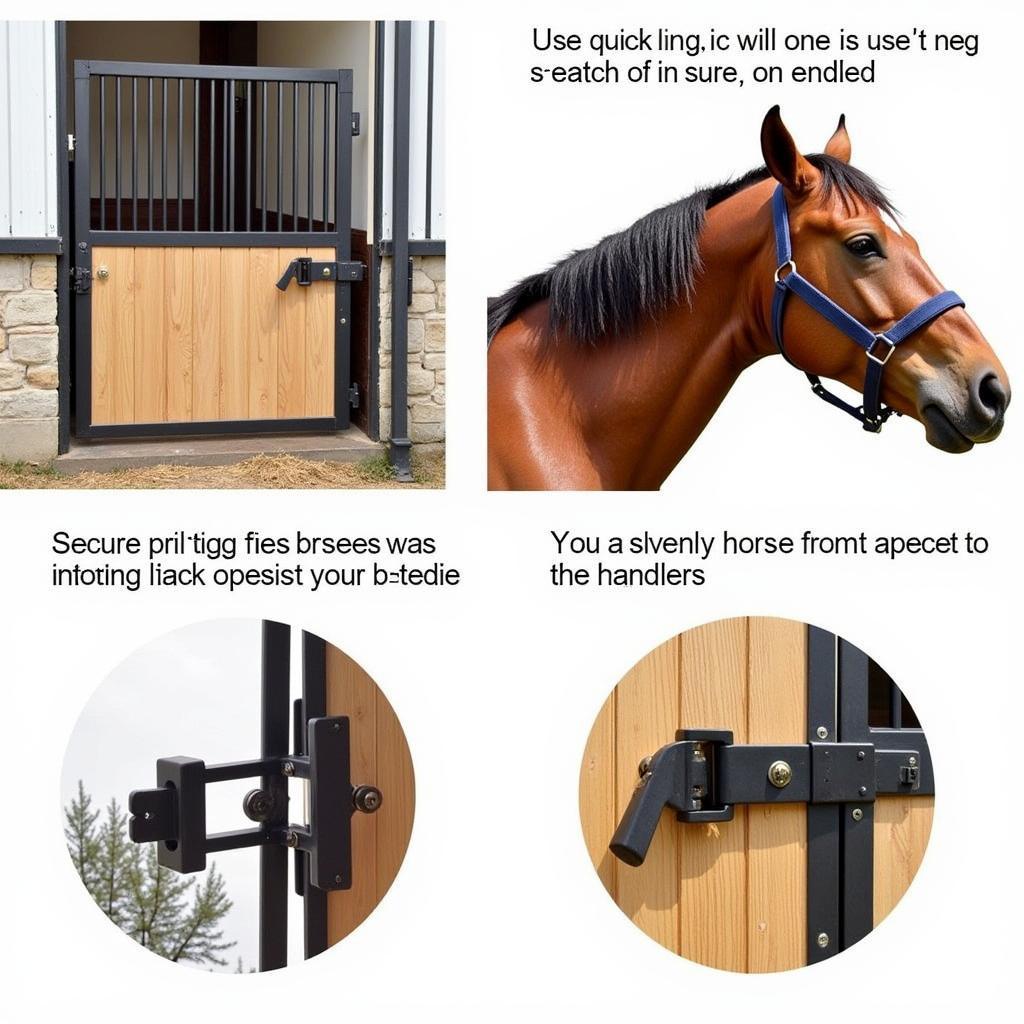Horse Gates For Stalls are a crucial element of any equine facility, impacting both the safety and well-being of your horses. Selecting the right gates involves considering various factors, from material and design to size and functionality. This guide will delve into the essential aspects of choosing the perfect horse gates for your stalls, ensuring a secure and comfortable environment for your equine companions.
Understanding Your Needs: Stall Size and Horse Temperament
Before diving into the specifics of horse gates for stalls, it’s crucial to assess your individual needs. The size of your stalls is a primary factor. A larger stall will require a wider gate, while a smaller stall might benefit from a sliding gate to conserve space. Consider also the temperament of your horses. A horse prone to cribbing or pawing might require a more robust and durable gate, such as those made from heavy-gauge steel. For gentler horses, a lighter wooden gate might suffice. Thinking about these factors early in the process can help you narrow down your choices. For those needing additional stall features, check out our selection of horse stall bars.
Material Matters: Durability and Maintenance
The material of your horse gates for stalls significantly impacts their longevity and maintenance requirements. Wooden gates offer a classic, aesthetic appeal but require regular upkeep, including painting or staining to protect against weathering. Metal gates, especially those made from galvanized steel or powder-coated aluminum, are highly durable and require minimal maintenance. However, they can be more expensive than wooden options. Composite materials offer a balance of durability and aesthetics, often combining the strength of metal with the look of wood.
Gate Styles: Sliding, Hinged, and More
Horse gates for stalls come in various styles, each with its advantages and disadvantages. Sliding gates are space-saving and easy to operate, making them ideal for smaller barns or stalls. Hinged gates are a traditional option, offering a wide opening and a classic look. Grill gates allow for better ventilation and visibility between stalls, promoting airflow and reducing feelings of isolation for the horses. Choosing the right style depends on your specific needs and preferences. For example, sliding gates are often preferred in big horse barns due to their space-saving design. Alternatively, if you are looking for more flexible options, our horse panel gates may be a good fit.
Safety First: Secure Latches and Hardware
No matter the material or style you choose, ensuring the safety of your horses is paramount. Opt for horse gates for stalls with secure latches that are easy for you to operate but difficult for horses to manipulate. Avoid latches with protruding parts that curious horses could injure themselves on. Check the hardware regularly for signs of wear and tear, replacing any damaged components promptly.
“A well-designed latch can be the difference between a secure stall and a potential escape,” says renowned equine veterinarian, Dr. Amelia Shepherd. “Invest in quality hardware to prevent accidents and ensure your horses’ safety.”
 Secure Horse Stall Gate Latch
Secure Horse Stall Gate Latch
Conclusion: Investing in Quality Horse Gates for Stalls
Choosing the right horse gates for stalls is an investment in the safety and comfort of your equine companions. By carefully considering factors like stall size, horse temperament, material, style, and hardware, you can create a secure and functional environment for your horses. Remember, prioritizing quality and safety will ensure the well-being of your horses for years to come. For those considering transporting their horses, check out our options for a secure and comfortable european horse trailer. Additionally, you can maintain a clean and dry stall environment with our effective mud control mats for horses.
FAQ
-
What is the best material for horse stall gates? The best material depends on your budget and maintenance preferences. Metal is durable, while wood is classic but requires more upkeep.
-
How wide should a horse stall gate be? The width depends on the size of your stall and horse. A standard size is around 4 feet.
-
Are sliding gates better than hinged gates for horse stalls? Sliding gates save space, while hinged gates provide a wider opening. The best choice depends on your barn layout.
-
What type of latch is safest for horse stall gates? Look for secure latches that are easy for you to use but difficult for horses to manipulate.
-
How often should I check my horse stall gates for maintenance? Regular inspections are essential. Check for wear and tear at least monthly, and more frequently if your horses are particularly active.
-
What are some common problems with horse stall gates? Common issues include rusting metal, rotting wood, and faulty latches.
-
How can I prevent my horse from escaping its stall? Ensure a secure latch and regularly check the gate and surrounding stall structure for any weaknesses.
Common Situations and Questions:
-
Scenario: My horse keeps cribbing on the wooden stall gate. Solution: Consider a metal or composite gate that is more resistant to cribbing.
-
Question: Can I install a horse stall gate myself? Answer: Yes, with the proper tools and instructions. However, professional installation may be easier and safer.
Further Exploration:
- For information on creating a comfortable stall environment, read our article on “Creating the Ideal Horse Stall Bedding”.
- Discover the benefits of different stall flooring options in our guide to “Horse Stall Flooring: Choosing the Right Surface”.
Need support? Contact us 24/7: Phone: 0772127271, Email: [email protected] Or visit us at: QGM2+WX2, Vị Trung, Vị Thuỷ, Hậu Giang, Việt Nam.